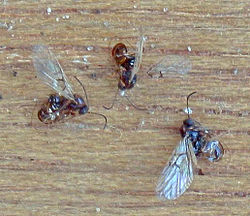| Neuroterus | |
|---|---|
 | |
| Neuroterus albipes | |
| Scientific classification | |
| Kingdom: | Animalia |
| Phylum: | Arthropoda |
| Class: | Insecta |
| Order: | Hymenoptera |
| Family: | Cynipidae |
| Tribe: | Cynipini |
| Genus: | Neuroterus Hartig, 1840 |
| Species | |
Many; see text | |

Neuroterus is a genus of gall wasps that induce galls on oaks in which the wasp larvae live and feed. Some species produce galls that fall off the host plant and 'jump' along the ground due to the movement of the larvae within.
Neuroterus saltatorius —formerly named Cynips saltatorius—produces such Mexican jumping bean-like jumping galls about 1 to 1.5 mm in diameter. [1] [2]
This genus was first described by Theodor Hartig in 1840. Like most oak gall wasps, Neuroterus species have two generations each year, one sexual and one asexual (or agamic). The galls induced by each generation of the same species are usually produced on different parts of the host plant.
Recent studies indicate this genus is poly- or paraphyletic, thus many species will likely be moved to other genera. [3]
- Neuroterus albipes
- Neuroterus alexandrae
- Neuroterus aliceae
- Neuroterus anthracinus
- Neuroterus aprilinus
- Neuroterus asymmetricus (Kinsey, 1922)
- Neuroterus bussae
- Neuroterus cerrifloralis
- Neuroterus fragilis (succulent gall wasp) [6]
- Neuroterus lanuginosus
- Neuroterus numismalis
- Neuroterus oblongifoliae
- Neuroterus quaili
- Neuroterus quercusbaccarum
- Neuroterus rosieae
- Neuroterus saltatorius (jumping gall wasp) [6]
- Neuroterus serratae
- Neuroterus stonei
- Neuroterus tricolor
- Neuroterus umbilicatus
- Neuroterus valhalla
- Neuroterus washingtonensis